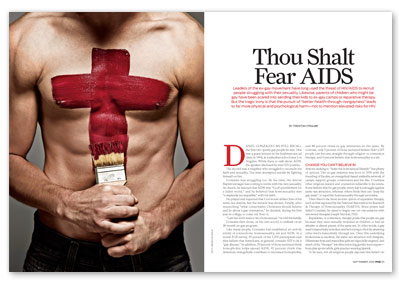 |
| Click here to read a digital edition of this article. |
Daniel Gonzales can still recall the first two openly gay people he met. One was a guest lecturer in his freshman sex-ed class, in 1994, at a suburban school near Los Angeles. While there to talk about AIDS, the speaker disclosed he was HIV positive.
The second was a neighbor who struggled to reconcile his faith and sexuality. The man attempted suicide by lighting himself on fire.
Gonzales was struggling too. At the time, the devout Baptist teenager was coming to terms with his own sexuality. At church, he learned that AIDS was “God’s punishment for a fallen world,” and he believed that homosexuality was “completely incompatible” with his faith.
He prayed and expected that God would deliver him of his same-sex desires, but the miracle was denied. Finally, after researching “what conservative Christians should believe and do about a gay orientation,” he decided, during his first year in college, to come out. Sort of.
“I am but don’t want to be a homosexual,” he told his family.
Gonzales then chose, on his own accord, to embark on an 18-month ex-gay program.
Like many people, Gonzales had established an unholy trinity of connections: homosexuality, sin and AIDS. In a recent POZ survey, 95 percent of the 1,200 participants said they believe that Americans, in general, consider HIV to be a “gay disease.” In addition, 75 percent of those surveyed think homophobia helps spread AIDS, 92 percent think that American evangelicals contribute to increased homophobia, and 88 percent think ex-gay ministries do the same. By contrast, only 5 percent of those surveyed believe that LGBT people can become straight through religion or conversion therapy, and 9 percent believe that homosexuality is a sin.
Change You Can’t Believe In
Anyone seeking to “leave the homosexual lifestyle” has plenty of options. The ex-gay industry was born in 1976 with the founding of Exodus, an evangelical-based umbrella network of camps, support groups, conferences and the like. Countless other religious leaders and counselors subscribe to its tenets. Some believe that for gay people, every day is a struggle against same-sex attraction, whereas others think they can “pray the gay away” or expel the homosexuality through exorcisms.
Then there’s the more secular option of reparative therapy, such as that espoused by the National Association for Research & Therapy of Homosexuality (NARTH). Since prayer had failed Gonzales, he opted to begin one-on-one sessions with renowned therapist Joseph Nicolosi, PhD.
Reparative, or conversion, therapy posits that people are gay because they were sexually molested as children or had an abusive or absent parent of the same sex. In other words, a gay man’s masculinity is broken and he’s trying to fix it by attaining other men’s masculinity through sex. Once this underlying brokenness is resolved, the same-sex attraction will dissipate. Effeminate boys and masculine girls are especially targeted, and much of the “therapy” involves enforcing gender stereotypes—boys play sports while girls practice wearing lipstick.
To be sure, not all religious people espouse this belief—in fact, many churches embrace LGBT congregants—but ex-gay practitioners are found among different races, socioeconomic backgrounds and religions. The Mormon version of Exodus is called Evergreen International. The Catholics have Courage, the Jews have JONAH (Jews Offering New Alternatives to Homosexuality), and for those attuned to 12-step programs, there’s Homosexuals Anonymous.
Among them all, one common message resonates: That homosexuality is unhealthy, that it comes with certain risks—especially HIV/AIDS.
“They all use HIV as a scare tactic, the ‘destructive, dangerous homosexual lifestyle’ as a recruitment tool,” says Wayne Besen, author of Anything But Straight: Unmasking the Scandals and Lies Behind the Ex-Gay Myth. “If there were a cure tomorrow for HIV, then I think these ministries would have significant trouble surviving, [because] they’d lose their largest fear-based message.”
It’s ironic then, that the ex-gay movement puts everyone—regardless of sexual orientation—at a higher risk of HIV. On the surface, the movement teaches that homosexuality is a choice. But it really pathologizes gay people as threatening the family structure, harboring mental illness, spreading disease and molesting children. And it actively promotes discriminatory laws.
Society responds by denying gay people their civil rights (if it’s a choice, you don’t deserve protections or equality), and by ensuring that schools and federal programs don’t “promote” homosexuality—or basic information about sexual health, including HIV.
All of which fuel the epidemic. It places the LGBT community—and those in ex-gay treatment—in physical and psychological danger. The stigma of being gay can result in low self-esteem, depression, addiction, unsafe sex and other markers of high-risk behavior. Practicing tough love, religious parents reject their gay children and make them more vulnerable to HIV. Meanwhile, ensuing legal restrictions hamper proven HIV education and prevention efforts.
The “Dangers” of Being Gay
The ex-gay movement conflates homosexuality with HIV/AIDS and misleads the public. It presents lies as scientific fact. It twists legitimate research. And it fuels anxiety by emphasizing certain data, such as when NARTH broadcasts the CDC finding that MSM in the United States have AIDS at 50 times the rate of straight men.
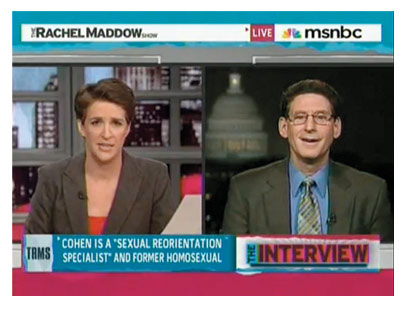 |
This fear mongering is best exemplified in the story of ex-gay Michael Johnston and the “documentary” It’s Not Gay: Former Homosexuals Tell a Story Few Have Heard. It was created in 2000 by the American Family Association (AFA), a Christian right organization. In the film, Bill Curnow, PhD, declares: “Committed same-sex relationships are a myth.”
“There’s no falling in love with a wife. No growing old together. No grandchildren. There’s just a lonely old man,” adds Johnston. “What kind of future is that?” Johnston tested positive for HIV in 1986, and he later developed AIDS. “[Being gay] put me on a path to living with dying,” he says as he walks through a cemetery during the film’s final moments.
The film is littered with alarming statistics—some of which are false or outdated. For example, David Miller, MD, claims that “30 percent of 20-year-old homosexual men will either have HIV or be dead of AIDS by the time they’re 30.”
This misinformation is troubling because of the AFA’s influence. It owns nearly 200 radio stations, and its web sites average 5 million visitors monthly. It’s Not Gay has been shown at thousands of churches according to AFA’s website where it sells for $12, or you can view it for free on Google Video.
Hallelujah! God Healed My HIV
“Today, with God’s abundant grace and His miraculous power to heal, I walk free from the AIDS virus.”
Thus spoke ex-gay Michael Lumberger, a former Exodus board member—one of the rare African-American leaders of the group—and director of Dunamis Ministries in Pittsburgh. Lumberger died unexpectedly in 2004 allegedly of heart problems, but not before his “amazing” (and entirely scientifically unproven) testimony was broadcast to the world.
Though not a dominant message of today’s ex-gay ministry, the healing power of Christ remains a common thread.
A recent example includes ex-gay pastor Matthew Manning, founder of Lighthouse World Evangelism. Manning appeared with Exodus president Alan Chambers in a 2007 episode of Joni, a talk show on Daystar, one of the largest Christian television networks in the world (the network reaches 81 million U.S. homes and more than 200 countries via satellite). Here’s a snippet of the transcript:
Manning: I lived a homosexual life up until about age 19…. One day I had an encounter with Jesus. I began to walk in my Christian life—with HIV though, and then in 1994 had a dramatic healing. I’ve been married for nine years. I have two children…and am totally set free. Set free almost 18 years now. Healed of HIV for 13 years.
Joni: Wow, that’s awesome.
[Close-up on applauding audience members.]
Joni [cont.]: That is an amazing miracle, to hear that someone was healed of HIV.
Chambers: It is amazing.… But God can do anything, and we serve that God.
Amazing, indeed. The website Ex-Gay Watch reported last year that Manning had never proved his HIV status and that he had been arrested numerous times for lewd or sexual conduct. (Manning was acquitted for one charge; another was dismissed; and the third he pleaded no contest.) Manning has since closed his ministry and gone in hiding.
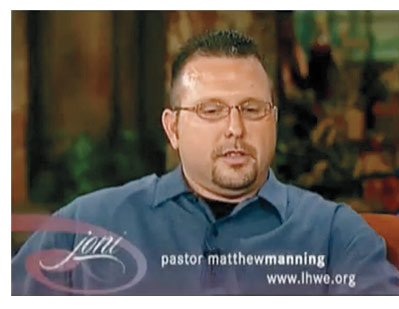 |
Perhaps Manning had a false positive on his first HIV test. Maybe he’s a longterm nonprogressor. Perhaps he’s like Lumberger, who later acknowledged in an e-mail to Besen that protease inhibitors played a role in his recovery. Could self-delusion and snake-oil salesmanship also play a part in these stories? We’ll probably never know for sure.
We do know that such claims can misinform a large number of people about the epidemic. And since many of the “cured” former homosexuals end up getting married and becoming parents, one can only hope the family members are tested for the virus—using good old-fashioned science.
Suffer the Little Children—and Adults Too
Five years ago, 16-year-old Tennessean Zach Stark blogged that his parents were forcing him to attend Refuge, a conversion therapy camp for teens run by Love in Action. The posts went viral, and the mainstream media discovered a new, youthful angle of the ex-gay story.
“Young people are now being used as ammunition in the evangelical Christian and political right wing’s war against equality for LGBT Americans,” concluded Jason Cianciotto and Sean Cahill, PhD, in a National Gay and Lesbian Task Force 2006 report titled Youth in the Crosshairs: The Third Wave of Ex-Gay Activism.
“Parents are being lied to by ex-gay and religious leaders they trust,” the report stated. “Parents are being told that homosexuality is a mental illness…which can be cured…and that if their sons and daughters are in the ‘homosexual lifestyle’ they are destined to lead short lives characterized by depression, anger, substance abuse and domestically violent relationships.”
Case in point: Joe Stark, Zach’s father, explained to the Christian Broadcasting Network why he forced his son into conversion therapy: “We felt good about Zach coming here [to Refuge]…to let him see for himself the destructive lifestyle, what he has to face in the future…. Statistics say by the age of 30 he could either have AIDS or be dead.”
The fact is that when parents, motivated out of genuine love and concern, reject their children’s sexuality, they place them at higher risk for HIV/AIDS.
This tragic irony was proved in a study published in Pediatrics in late 2008 titled “Family Rejection as a Predictor of Negative Health Outcomes in White and Latino Lesbian, Gay and Bisexual Young Adults.” Researcher Caitlin Ryan, PhD, with the Family Acceptance Project at the San Francisco State University, and her colleagues found that youth whose families rejected them for their sexual orientation and gender expression were at higher risk for being unhealthy as young adults.
Specifically, LGB youth who reported high levels of rejection were 8.4 times more likely to report having attempted suicide, 5.9 times more likely to report high levels of depression, 3.4 times more likely to use illegal drugs and 3.4 times more likely to report having unsafe sex—all factors that increase one’s risk for HIV—compared with LGB peers who reported no or low levels of rejection.
As obvious as this may seem, it’s the first study to examine this link and show that rejection, not homosexuality, causes these health risks.
Even a little bit of acceptance can make a difference. For example, youths of moderately rejecting families were 2 times more likely to attempt suicide, while those in highly rejecting families were 8 times more likely.
But in many cases, family rejection is so extreme that LGBT kids run away or are kicked out of the house. It’s estimated that 20 to 40 percent of homeless youth identify as LGBT (about 3 to 5 percent of the U.S. population identifies as gay or lesbian). And homelessness, with its high incidence of drug use and sex work, is a high-risk factor for HIV.
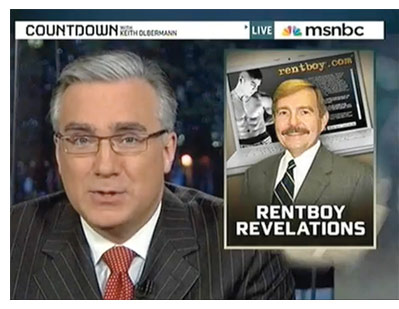 |
Youths in Ryan’s study were also asked whether they believed they can be a happy LGBT adult. Only one in three youths from highly rejecting families thought so, while nearly all of the youth from extremely accepting homes did. “People who have no sense of the future,” Ryan points out, “are living moment to moment. And what’s the point in using condoms if you don’t [think there’s a future] to keep yourself around for?”
These findings don’t only apply to youth. Ex-gay ideology promotes stigma and shame, says Cahill (now at Gay Men’s Health Crisis), and that relates to HIV because if you have high self-esteem, you take better care of yourself and make better decisions about your health.
“We have data that show that gay people who are out and feel good about themselves as gay men are more likely to practice safer sex than guys who are in denial,” says Cahill, referencing separate research by the AIDS Project of Los Angeles and the New York City Health Department. “Particularly those who are struggling with identity issues—who lead a compartmentalized life where they’re not their full selves—they’re often the ones more likely to engage in riskier HIV behavior.”
Remember Michael Johnston? It’s Not Gay wasn’t his only starring role. In 1998, he was featured in the nationwide television and print campaign “Truth in Love.” Paid for by a cabal of antigay religious right leaders, the ads introduced the general public to the term “ex-gay” and the damaging concept that sexuality was a choice. Johnston’s “Truth in Love” spot featured him and his mother with the headline: “From innocence to AIDS. One mother’s plea to parents of homosexuals.”
Then came his “moral fall,” as the AFA described it. In 2003, Besen broke the story: HIV-positive Johnston had been cruising online, lying about his HIV status and hosting bareback gay sex parties.
Today, Johnston takes refuge in Pure Life Ministries, which caters to Christians dealing with sexual sin. Meanwhile, the AFA still promotes It’s Not Gay, boasting that it’s a best seller.
Johnston’s story, Besen says, illustrates a common ex-gay narrative: Gay people are told they’re going to hell—and the conservative religious ones genuinely believe it—so they go to these ministries to change. When it fails, they think God hates them, leaving them even more damaged and with lower self worth. “These ministries make people act recklessly,” Besen says. “They hold back and hold back, then the dam breaks and they go on these sexual binges.”
Go Ye Into All the World and Preach
A major evangelical tenet is spreading the gospel. As part of this outreach, evangelicals have turned to Central America, Eastern Europe and Africa. But when the messages of Christ’s love are with mixed with antigay fear, the volatile results can be deadly.
Just look at Uganda. Powerful evangelical leaders such as the Rev. Rick Warren and right-wing politicians such as U.S. Senator James Inhofe (R–Okla.) have long held sway in the struggling African nation. In March 2009, antigay Holocaust revisionist Scott Lively, Exodus International board member Don Schmierer and ex-gay counselor Caleb Brundidge (a protégé of infamous ex-gay therapist Richard Cohen) headlined a conference in Kampala titled “Exposing the Truth About Homosexuality and the Homosexual Agenda.” Among the talking points were criminalizing homosexuality, which is already illegal there, and forcing gays into conversion therapy.
Six months later, the world discovered what such animus wrought: the so-called “Anti-Homosexuality Bill,” legislation calling for the death penalty for certain homosexuals and HIV-positive people. The bill bans all LGBT activities and organizations, and it requires citizens to report any gay people they might know. This spring, lawmaker Beatrice Rwakimari followed up with a bill criminalizing HIV transmission and mandating HIV tests for certain people.
As POZ went to press, both bills remained before the legislature. Whatever the outcome, one thing is clear: They will diminish the health of the people they persecute.
According to a report by the Joint United Nations Programme on HIV/AIDS (UNAIDS), in countries that ban discrimination, UNAIDS can reach—and therefore save—about 60 percent of MSM with HIV prevention services. In countries where MSM are not protected, that number drops to about 35 percent. What’s more, Michel Sidibé, the head of UNAIDS, told reporters that in countries such as Malawi and China, with discriminatory laws, about 33 percent of new HIV infections are among MSM. In countries that don’t criminalize this minority, the new HIV incidence rate among MSM plummets to between 3 and 6 percent.
Efforts to reach this high-risk group are undermined by homophobia. And homophobia is fueled by ex-gay ideology. A prime example is the Kenya Medical Research Institute (KEMRI) in the Muslim town Mtwapa. KEMRI provides HIV/AIDS services, including MSM outreach. In February, a group of bishops, preachers and imams held a press conference against KEMRI and the MSM who work at and visit the site. The next day, a mob attacked the center and then went on a witch hunt for people suspected to be gay.
Is it a coincidence that three months earlier, the American ex-gay group Homosexuals Anonymous, led by Doug McIntyre, spoke at 15 local Kenyan schools and held a conference for almost 200 church leaders?
Ex-gay ideology isn’t limited to Africa. Exodus Global Alliance also encompasses Asia Pacific, Brazil, China, Europe, the Middle East, India, Latin America and Canada. Homosexuals Anonymous has chapters in El Salvador, New Zealand and Germany. The list goes on.
Revelations: An Apocalyptic Future?
Meanwhile in the United States, well-adjusted, healthy gay people abound—many in stable relationships and raising children. Most HIV-positive people live well beyond 30—and many could live well into their 80s. Professional groups like the American Psychiatric Association denounce reparative therapy as unethical and dangerous. And more and more ex-gay survivors like Daniel Gonzales—the former reparative therapy patient is now an openly gay architect in Denver—are telling their stories to educate the public. As a result, more people view the ex-gay movement as fear-based propaganda and consumer fraud.
Besen, who still covers the movement via TruthWinsOut.org, says the U.S. ex-gay market is losing ground. Exodus no longer promotes complete and quick change to heterosexuality and instead talks about a lifelong process akin to battling alcoholism—in fact, it prefers the term “strugglers” over “ex-gays.” Its president, Alan Chambers, tells POZ the group is leaving the culture wars and will remain neutral on political issues.
But the war isn’t over. The next battle is for the minds of America’s children. By pushing the Helms Amendment, a.k.a. the “no promo homo” law, antigay foes threaten school districts with lawsuits if they even mention gay people (or, similar to a Staten Island case, HIV education). They’re trying to ensure ex-gay leaders get equal floor time in any LGBT discussions. In March, George Rekers, PhD, an antigay psychologist-cum-minister, under the guise of the American College of Pediatricians, sent a “Facts About Youth” newsletter to 14,800 school superintendents. It presented the usual ex-gay lies as unbiased, scientific research. But fate intervened, and Rekers lost credibility when he was caught hiring a rentboy.com escort to carry his luggage—and give him massages—during a European vacation.
It’s easy to snicker. Homophobes and ex-gay leaders are getting caught with their pants down (literally). But the truth is, people are vulnerable to the ex-gay message because they’re grappling with their sexual identity and spirituality, because they were molested as children, they’re effeminate or because they face very real rejection. These people deserve empathy, not ridicule; professional help, not propaganda.
“The bad guy is not the [person who seeks out an] ex-gay program,” says Peterson Toscano, another ex-gay survivor–turned–advocate. “The bad guy is a society that insists that being heterosexual and gender normative is more valuable than being gay.”
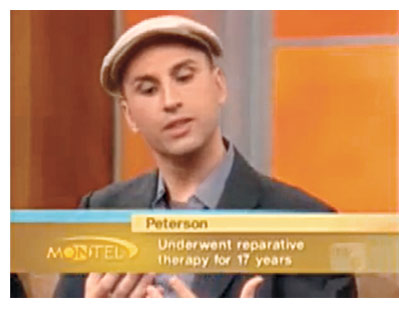 |
Toscano spent 17 years in reparative therapy—and over $30,000—before he broke free of the ex-gay grip. Now, he’s a performance artist who lives with his partner, Glen, in Pennsylvania and preaches his new philosophy through lectures, film and plays such as his Doin’ Time in the Homo No Mo Halfway House—How I Survived the Ex-Gay Movement and through the website BeyondExGay.com.
“I know who I am, it is beautiful, it is good, it is me,” he says. “You could even say that being gay is a gift from God.”
Amen to that.






21 Comments
21 Comments